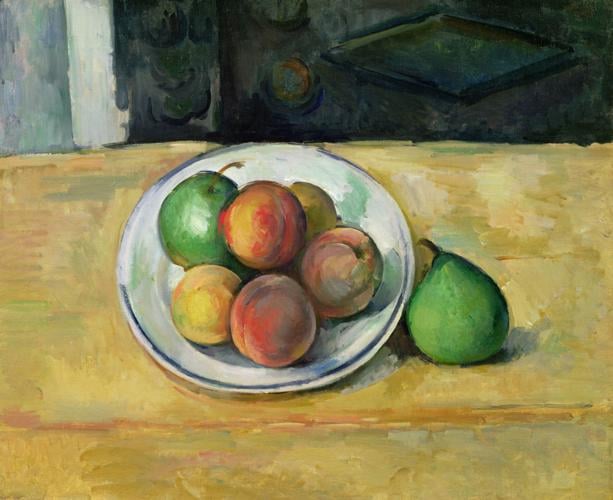Whenever the subject is Paul Cezanne (French, 1839-1906), comparisons with Edouard Manet (French, 1832-83) are inevitable, as both artists have been independently considered the “father of modern art.” The exhibition “Cezanne: In and Out,” available online at the Museum of Fine Arts, Boston, invites us to compare the contribution of each one to art history, taking advantage of the opportunity to conduct a new “paternity test.”
Art movements do not follow a linear pattern; they move back and forth. Briefly noted, 14th- and 15th-century Renaissance artists found their inspiration in classical antiquity; between the 17th and early 18th centuries, Dutch Baroque times, lofty mythological and religious themes were replaced by scenes of daily routine of its denizens, only to have this approach reverted to antiquity themes during the 18th- and 19th-century Neoclassicism. The latter was the art movement embraced by French artists in late 19th century, and as France dominated the art world in that period, neoclassicism became the “norm” again.
First things first. What makes art really groundbreaking? We put forward the following two-word criterion: lasting originality. Appropriating aspects of old art can be creative, but it does not make it original enough, let alone lasting, to justify “paternity” of a movement, in this case modern art.
Enter Manet. There are art historians who consider his painting “Le Dejeneur sur l’Herbe (Luncheon on the Grass)” (1862), at the Musée d’Orsay in Paris, to mark the very beginning of modern art. In it, the artist questioned lofty mythological and religious themes opting for art featuring real people living their daily lives — with a big twist.
The composition in that painting juxtaposes two men sitting on the grass talking and a nude woman looking as the viewer (the twist). This artwork — experts on Manet’s side claim — shows innovations by Manet such as: men wearing contemporary attire; the nude woman looks like a real woman, not a mythological one (note her clothes near her on the ground, indicating that she disrobed earlier); and lastly, the fact that she is looking at the viewers further takes this painting into innovation territory. However, we contend that these innovations were actually borrowed, appropriated or recycled from 15th- and 16th-century Italian paintings and engravings.
First of all, the composition and theme of the painting are identical to the lower right side of the Greek mythological theme of “The Judgment of Paris” (c.1510-20) engraving by Marcantonio Raimondi (Italian, 1470-1534) after an artwork by Raphael Sanzio (Italian, 1483-1520). In the engraving, the nude mythological woman is also looking directly at the viewer, so Manet did not create anything new here.
Then, there is Giorgione’s (Italian, 1470-1510) and later attributed to Titian (Italian, 1488-1576) “Le Concert Champêtre (The Pastoral Concert)” (c.1509). In it the artist depicts four main figures: two clothed men sitting on the grass talking, and two nude women, one pouring water into a well and the other sitting with the men, playing a flute. Once again, two naked women and two smartly dressed men; it was done before Manet’s 1862 seminal painting.
Finally, in “The Flagellation of Christ” (probably 1468-70), Piero della Francesca’s (Italian, 1416-92) masterpiece, the painter depicts three men wearing period Renaissance clothes talking among themselves in the foreground, while Roman soldiers in uniform are whipping Christ in the background. In other words, men were already depicted wearing contemporary clothing almost 400 years before the “Luncheon on the Grass.”
Cezanne has also been called the “father of modern art,” primarily for breaking with Classical single-point perspective that gives the illusion of three dimensions and depth to a painting. He introduced multi-viewpoint — an example is at the MFA, Boston exhibition with his “Still Life with Peaches and Pears” (1885-87). In it, a bowl of fruit is viewed from above, and a nearby pear seen from the side, casting its shadow to the right — as it seems to capture two perspectives at once. Compare it to Manet’s “Basket of Fruit” (1864), and it will be noted that the modernity of Cezanne’s version comes to life.
Cezanne’s multi-view perspective innovation was created “ex-nihilo” (out of nothing). He did not copy anyone. It was Picasso, arguably the best-known artist of the 20th century, who said, “Cezanne is the father of us all.” Cezanne’s multi-point perspective presents evidence that he was an original during his days and into the 20th century. His influence was felt in entire movements, Cubism down the line to Abstract Impressionism, and artists such as Picasso, Braque, Van Gogh and Gauguin. In summary, based on the “lasting innovation” criterion “admitted in art court,” Cezanne is the “father of modern art.”
“Cezanne: In and Out of Time,” online now at the Museum of Fine Arts, Boston, places 12 paintings by Paul Cezanne — five from the MFA’s collection and seven from private collections — in dialogue with works by his peers and forebears, Manet, Degas, Renoir and Pissarro, looking at the trailblazer artist and considering what sets him apart. Indeed, the show gives a unique opportunity to enjoy artworks of no less than the “founder of modern art.”




